Vietnam embraces new wave of investments: HSBC
Society – Economy - Ngày đăng : 12:21, 06/11/2024
The latest trend observed reveals the prowess of the investment flows of the Chinese market across diverse sectors and industries. Mixue, a leading bubble tea and ice cream parlor brand, has topped the Vietnamese market with over 1,000 stores; whilst global electronics players such as Luxshare, Geortek, Foxconn, Pegatron, and Compal continue to invest heavily into the ecosystem.
Hualian Ceramic, a leading household ceramics company, is looking to create a ceramic valley, while Sailun Group has made commitments for more investments into their tire manufacturing factory.
Over recent decades, Vietnam has grown to become tightly intertwined with the global supply chain, advancing into higher value electronics sector and witnessing seven times growth in exports since 2007, with 70% of them being driven by FDI companies. The leading FDI provider over the years has no doubt been the Republic of Korea, with giant names like Samsung, LG, Hyundai, and Lotte. In addition, Singapore and Japan have also joined the competition with great success.
However, the dynamics of FDI inflow and the investor landscape is shifting since the second half of 2023 and becoming more evident this year. Trade between the two markets has grown 10-fold since 2007, with the nation now playing a pivotal role in the downstream segment of the Chinese manufacturing supply chain. In addition, from a newly registered FDI angle, the China corridors, Hong Kong, and Taiwan are collectively contributing to 60% of the aggregate flow compared to 38% in 2022.
Taiwan (China) continues to expand and deepen its presence in the Vietnamese market as a means to relocate and diversify their supply chains. The Taiwanese 2016 New Southbound Policy has helped to boost investment flow, whilst the Vietnamese side’s multiple bilateral and regional FTA pacts have catalyzed those global Taiwanese manufacturers to leverage on Vietnam as a cost-effective platform exporting to US, Europe, as well as intra-Asia.
The HSBC economist points out several factors for the expansion of FDI from China. Firstly, ASEAN markets are actually benefiting from import of cheap inputs from the northern neighbour to become competitive and in turn to achieve trade surplus position with the rest of the world. Vietnam therefore serves as a classic case and one of key beneficiaries.
Secondly, investment flows are also a response to growing domestic market backed by the growing middle-income class within the 100 million population where the median age is 30 and 70% are among the working population.
Lastly, manufacturing wages is less than half of that in China and the second lowest in ASEAN behind Philippines, with electricity pricing being the second lowest in ASEAN just behind Indonesia and diesel prices being the second lowest only behind Malaysia.
The think tank emphasizes that there has been significant progress made in executing both bilateral and regional FTAs, with the FDI Regulatory Restrictiveness Index indicating that Vietnam is the most open economy just behind Singapore in the region, whilst the 20% statutory corporate income tax rate reveal comparative advantage against markets such as China, the Philippines, Malaysia, and Indonesia.

